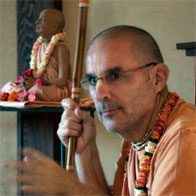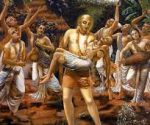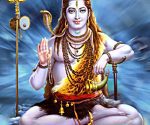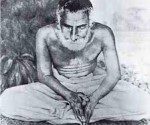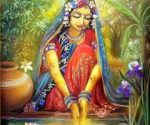Kirtana Prabhave Samarana Svabhave
March 22, 2013 (VNN) by Swami Tripurari
“Kirtana prabhave samarana svabhave.“
This phrase from Vaisnava ke? encapsulates Srila Bhaktisiddhanta Saraswati Thakura’s approach to smarana of the raga marg. It states that by the power of kirtana, smaranaon one’s spiritual prospect in lila seva will arise naturally, as opposed to forced, mechanical meditation that does not arise out of Harinama and is undertaken beforeceto darpana marjanam is attained.
Harinama is actually central to raga marg and smaranam is to be fortified by it. Furthermore it is Harinama that one can engage in despite an impure heart, whereassamranam requires a pure heart in order to engage in it effectively. Mahaprabhu has shown this by his own example, and he is Krsna in his acarya-lila. He has also taught this in his Siksastakam.
Adkhikara for siddha rupa seva is a widely debated issue, with conservative and liberal interpretations of lobha. However, Sri Jiva Goswami has in my opinion written most authoritatively on the subject in his Bhakti-sandarbha, leaving little room for doubt.
Bhakti is not our right but a gift. Granted it is given with diksa in terms of the opportunity to pursue it—the effort to attain more grace, if you will. Sadhana is an effort to attain grace in the form of the blessing of bhava.
Raganuga sadhana is a big subject and it is explained in different ways by different lineages. The Bhaktivinoda parivara tends to take a conservative approach, as do a number of other Gaudiya parivaras. What follows is a description of such a conservative approach.
As far as our choice for rasa, this is repeatedly explained by the Goswamis to be a result of association. With whom one associates one becomes like—samskara. This is the general rule. What appears to be an exception must then be attributed to previous association in another life or the fact that, for example, other bhavas such as sakhya are contained within madhurya. Thus one such bhava may become the bhava of a disciple of the madhurya rasa guru that the disciple is serving.
Then again, the guru is representing Rasaraja, and thus in a general sense all rasas. Looking at it this way, even a guru in sakhya rasa can give madhurya rasa—just as the president comes from a particular state with state affinities but as the president he or she represent all of the states. As saksad hari tvena the guru represents all possibilities, whereas—kintu prabhur ya priya eva tasya—he or she also has a particular sentiment that most disciples will follow—krsnanandaya dhimahi.
The choosing of a sentiment described by Thakura Bhaktivinoda is tied to ruci. Ruciconstitutes the absence of material desire—na dhanam na janam na sundarim kavitam va—and the dawning of three spiritual desires: praptya-abhilasa, anukulya-abhilasa, and sauhrdha-abhilasa—the desire to attain Krsna, the desire to serve him favorably, and the desire to establish a particular affectionate relationship with him. These desires begin to manifest in the stage of ruci, and thus in the context of serious and deepsadhana, wherein the medicine of chanting has become one’s food.
The feeling that the desire to establish a specific affectionate relationship with Krsna is one’s own choice is a particular perspective. Actually it descends or arises in the purified heart through sadhana, as nama smaranam develops into rupa and then guna smaranam, or natural, self-arising meditation on a particular from of Krsna and particular qualities of his (out of the 64) relative to the affectionate relationship desired.
Sri Jiva Goswami explains in his Durgama-sangamani that the ruci aspect of bhava(rucibis citta masrnya krd) is constituted of these desires. So before attaining bhava, asruci itself is attained these desires begin to manifest. But unlike the stages of asakti andbhava wherein they flow spontaneously, in ruci they are cultivated with one’s intelligence. Sri Jiva says about the stage of ruci that, “Ruci means desire for the Bhagavan, that is directed by the intellect”—rucir abhilasah kintu buddhi-purvakam.
But in nistha one can also fix one’s ideal on the basis of deep study of sastra that this stage typically involves—nityam bhagavata sevaya. Or on the basis of serving the person Bhagavata and desiring to follow him or her internally. And this will likely give rise to a corresponding desire in ruci. Or even before that in earlier stages the guru may tell us that we are to follow a particular bhava as our ideal. However, in the stage of anistha bhajana kriya and before anartha nivritti, eligibility for lila smaranam from the perspective of one’s desired affectionate relationship is surely lacking. How can one meditate effectively when one is distracted by other desires, other values (principal anarthas)? Meditation unlike kirtana requires eligibility. Thus Sri Jiva recommends nama smaranamfirst, which when done attentively cleanses the heart and develops naturally into rupa,guna, and in asakti, lila smaranam. Rupa, guna, and lila are all within the name. And it is Thakura Bhaktivinoda who cautions against premature attempts at such lila smaranamin his Bhajana-rahasya: “The intelligence of one who thinks of his siddha-deha without first achieving eligibility becomes bewildered.” He calls this sahajiya-bhava.
Following the above, one who has not attained ruci but is attracted to the idea of following the bhavas of the Vrajavasis is an “ajata-ruci raganuga sadhaka.” This is the language Jiva Goswami uses to describe such a sadhaka who has become attracted to the raga marg as a result of associating with a sadhu on that marg but who at the same time is not fully eligible to tread it. Treading it requires doing so in two bodies, a sadhaka deha and a siddha deha. Thus one can follow this marg with a sadhaka deha, as Jiva Goswami explains, before one begins serving in one’s siddha deha in meditation. One does so by adhering to the hearing and chanting of vaidhi bhakti with the aspiration to eventually attain such a siddha deha and full eligibility to tread the raga marg. This is then a mixture of raga and vaidhi sadhana with the aim of attaining further eligibility for pure raganuga sadhana that is driven by ruci. The idea is that the siddha deha arises out of the fully engaged/absorbed sadhaka deha. Today, many want a siddha dehawithout taking the trouble to fully engage their sadhaka deha.
Where does lobha fit in? In the lowest sense of the term it constitutes the desire to follow the bhavas of Vraja, as opposed to the majestic love of Vaikuntha. This sets one on the path in as much as the path differs from pure vaidhi bhakti only in terms of orientation and subsequent ideal. But lobha in and of itself does not turn one into a jata-ruci raganuga sadhaka. First comes ajata-ruci raganuga sadhana. And continuing along conservative lines, Mukunda Goswami has commented in his Bhaktirasamrita-sindhu tika that lobha for raganuga sadhana is more rare than bhava of vaidhi bhakti, which Sri Rupa describes as sudurlabha, very rare.
At any rate, while raga bhakti is open to all, qualification to tread the path in all respects is something that is gradually developed, as Jiva Goswami has explained. Indeed many who aspire for Vraja prema cannot even participate in such discussions due their present lack of eligibility.
Knowledge related to one’s siddha deha and esoteric raga marg practices can be attained in one of three ways. One can hear about these from one’s diksa guru, from one’s siksa guru, or they may be revealed through sadhana. The first two possibilities speak of information that will gradually need to be realized. The third speaks of gradual realization independent of any specific information. The venerable Visvantha Cakravarti Thakura explains this in his Ragavatma-candrika. He cites the following Bhagavatam verse (SB 11.14.26) as evidence in support of the third method.
“Just as a diseased eye treated with medicinal ointment will gradually see more clearly, similarly a conscious living entity—the seer—when purified by hearing and chanting about my virtues, will gradually be able to see more clearly the underlying reality.”
Commenting on this verse the Thakura writes this knowledge manifests in the heart that has been purified by practices such as nama-sankirtana. Thus it is nama sankirtana, thesadhana Sri Caitanyadeva gave to the world, that leads to the purified condition of the heart in which realization of one’s prospect in lila-seva manifests. The stage of sadhana bhakti that corresponds with such a purified heart is ruci, characterized marginally by the absence of material desire, na dhanam, na janam, na sundarim, . . . and principally by desire only for bhakti, bhavatad bhakti ahauituki. This is the stage of sadhana in which the submission that characterizes one’s disposition in sadhana bhakti begins to move substantially and meaningfully in the direction of the longing that characterizesbhava-bhakti. Remembering the phrase of Srila Bhaktisiddhanta Saraswati Thakura “First deserve, then desire,” in this ruci we find spiritual desire well deserved.




